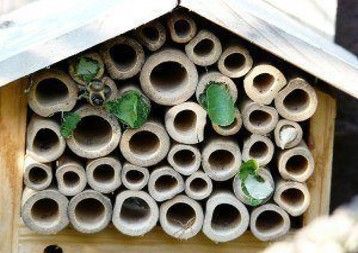Tuleyome's Science Corner: California's Native Bees

Bee Condo
I would venture to guess that many of us can recognize a honey bee. Certainly, we can appreciate the role they play in our ecosystem and benefits they provide. They even provide an undeniably successful example of cooperation. But, did you know that there are 1,600 species of bees that are native to California? They are incredibly diverse in appearance, habits and habitats.
With the exception of a few, native bees are primarily solitary. They may be nesting around our gardens and we may not even know they are there. Some of them nest in the ground, some of them in wood, plant stems or even old snail shells. Sometimes they can even be seen hovering around the same blossom as honey bees, patiently waiting their turn.
Native bees are categorized into several groups. Below are some of the more common groups and species that you may see nearby.
The Apidae group is large and does include honey bees. Most species in this group are hefty and stout, and are great pollinators because of their robust, hairy bodies and their energetic foraging habits. Two native species in this group that you have probably seen are carpenter bees and bumble bees. Some species are solitary but others live in colonies. Carpenter bees nest in soft wood or pithy stems while bumble bees are social and nest in cavities or hives. The group also contains native digger bees which nest in the soil and native cuckoo bees which are parasitic and lay their eggs inside another bee’s nest. The cuckoo bee egg hatches early and the larvae eats the host bee’s food stash and/or the host bee’s larvae.
The Halictidae group also called “sweat” bees because their endearing habit of landing on people’s skin to lap up sweat for moisture and salt! One of my favorites in this group is the green sweat bee because of its spectacular iridescent green exoskeleton. Most of the species in this family nest in the ground but a few nest in wood. Many species in this group have a less endearing habit called cleptoprasitism which means they lay their eggs on other bee species food supplies and after hatching it kills the host’s larvae.
The group Megachilidae is also a very large group of bees. They nest in decaying plant stems, holes in wood and even old snail shells. Sometimes called the architects of the bee world, the female makes chambers for her larvae using mud, plant hairs, pieces of flowers and leaves or even tiny pebbles. This group contains leafcutter bees which, if present in your garden, will leave tell-tale signs of circular holes in leaves. Leafcutter bees are also vital for cherry and almond pollination. Another bee in this group is mason bees which uses mud to seal off the entrance to their nest. Fun fact - if you’ve purchased a bee house that consisted of bamboo tubes, the most likely species to set up residence in it are mason bees!
The group Andrenidae is most commonly known as mining bees. They nest in the soil, hence their clever name! Small and solitary, these bees are oligolectic meaning they get all of their pollen from only a few select flowers. Females build branching, underground tunnels that they fill with pollen to lay their eggs on. The eggs hatch and the larvae go through their metamorphosis entirely underground and are one of the first species to emerge in the spring.
More information about our native bees is available via the UC Berkeley Urban Bee Lab.
-Kristie Ehrhardt; kehrhardt@tuleyome.org
Tuleyome Land Conservation Program Manager
RECENT ARTICLES






